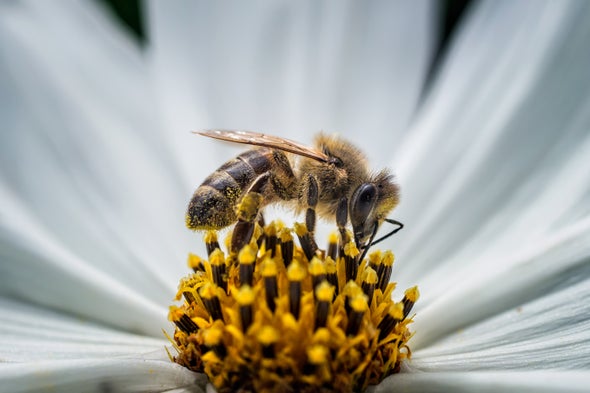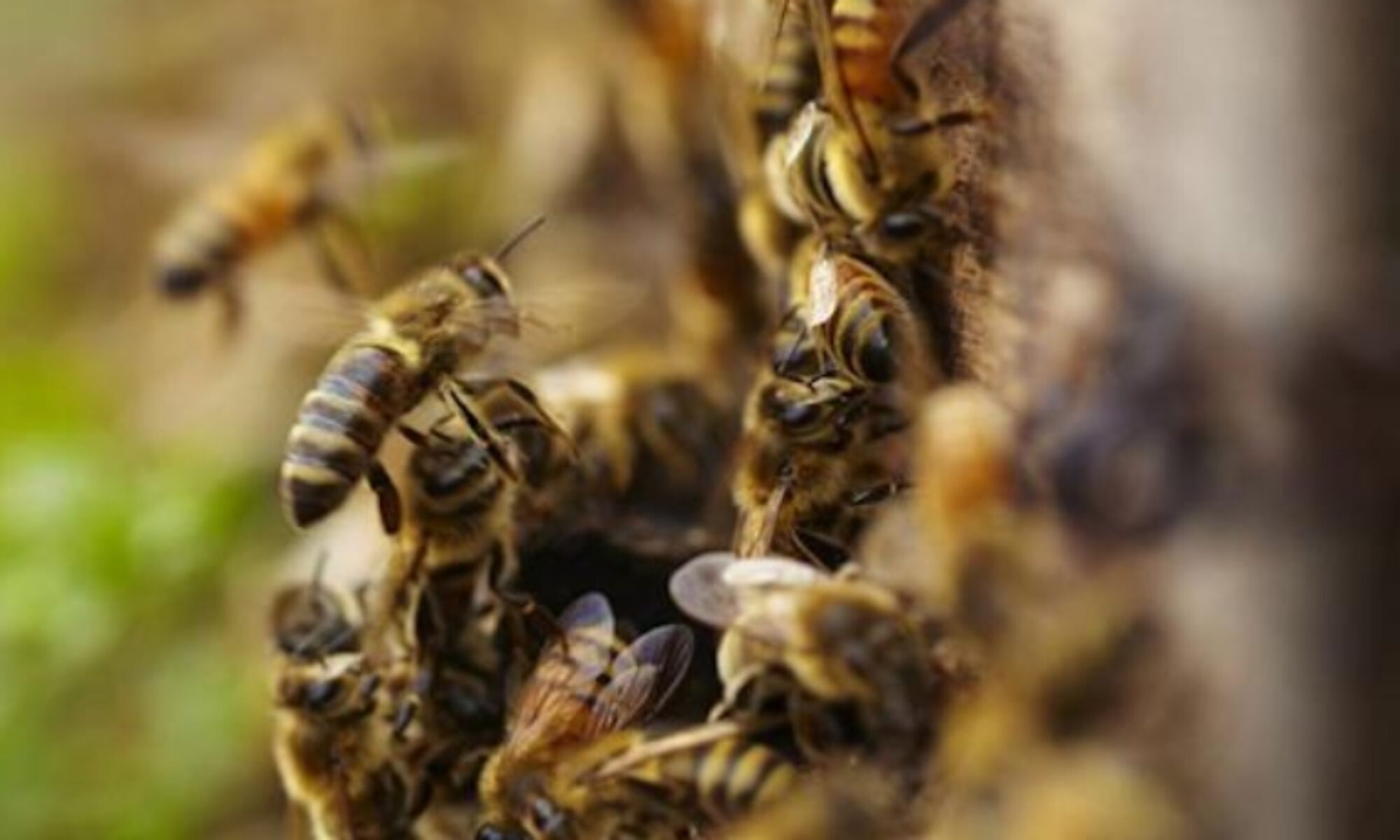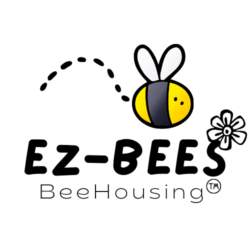Scientific American, By Paige Embry on August 23, 2019
Microbes in flowers are crucial to bee diets, and microbiome changes could be starving the insects

Ask an entomologist what makes a bee a bee, and you’ll likely get some version of “bees are just wasps that went vegetarian.” New research shows that isn’t true. Bees are actually omnivores, and their meat is microbes. This finding may open a new window on why bees are in trouble: Anything that disrupts the microbial community in a bee’s food, whether it is high heat linked to climate change, fungicides or another stressor, could be causing developing bees to starve.
Bees are supreme pollinators because of what their babies eat. Most animals visit flowers to pilfer nectar, and they may or may not brush up against pollen and carry it to the next flower. Female bees, conversely, deliberately collect pollen, along with nectar, to feed their babes. This larval food choice is part of what defines a bee.
Scientists have known for decades that fermenting microbes are present in pollen, but no one had seemed to consider whether they were also an important food for bees. The microbes function as an “external rumen” that breaks down parts of the pollen. It stands to reason that bees might ingest some microbes, but two researchers decided to investigate whether they eat enough to make them omnivores—and if the bees truly need those microbes to thrive.
Prarthana Dharampal of the University of Wisconsin–Madison and Shawn Steffan, who works jointly at the university and the U. S. Department of Agriculture’s Agricultural Research Service (ARS), assessed 14 different bee species in six of the seven bee families. They found that bees eat substantial amounts of microbes, enough to change how they fit within food webs. Scientists use a scale to categorize where organisms belong in that web: those that make their own food, such as plants, register at so-called trophic position 1 (TP 1), herbivores register at TP 2 and carnivores do so at TP 3, or even higher if they eat other carnivores. The average TP across all the bees studied was 2.6, putting them squarely in the omnivore spot, halfway between herbivores and carnivores. Interestingly, the trophic position varied among families, ranging from just a bit above herbivores (2.11) to solid carnivores (3.09). Now that the TP is known, Dharampal says she wonders whether bees are really foraging for the pollen, or are foraging for the microbes that are associated with the pollen.Advertisement
For most people, the idea that microorganisms can qualify as meat is radical.In the past four years, Steffan and his colleagues, including Dharampal, have published a series of papers laying out their evidence that microbes are an important part of a variety of food webs, including those that involve bees. Their findings confirm that fungi, bacteria and other microscopic players can fit anywhere in the food web, upending our vision of predator and prey, carnivore and herbivore—and what makes a bee a bee.
Steffan and his colleagues have also shown that microbial meat is a necessary part of bees’ diet. The researchers tested a species of mason bee that lays eggs in aboveground tubes that are easy to access and transport. In each tube, the mason bee lays a series of eggs, each on its own wad of pollen and nectar. The researchers had a Utah beekeeper send them a batch of tubes immediately after the bees filled them. They then took the eggs off the wads and separated males from females and used only the male bee larvae, divided into seven groups of 12. The scientists sterilized half of the pollen and then fed different mixes of sterilized and unsterilized pollen to the groups. As the percentage of sterilized pollen in the food increased, so did the larvae’s likelihood of dying. The larvae also weighed less and took longer to mature. “Microbes are a very important source of nutrients for these bees,” Dharampal says. “If you take away this critical source, or portion, of their diet, they suffer tremendously.”
The idea that bees are vegetarian is entrenched in entomology, and Steffan admits he and his colleagues ran into headwinds when trying to get their papers related to omnivory in bees accepted. Ultimately, they were published in the American Naturalist and Proceedings of the Royal Society B, respectively. Gloria Degrandi-Hoffman, who works for ARS and has investigated the honey bee microbiome but was not part of the work, says that the scientific community is always skeptical. When a new finding goes against a widely held perception, people take some convincing.
The mason bee results suggest that bees could suffer or starve if certain microbes disappear from their diet. Scientists have attributed the declines of both managed and wild bees to various combinations of habitat loss and degradation, pests and pathogens, pesticide exposure and climate change. They have largely focused on how such factors impact bees directly. The next step is to look at whether the stressors may affect the pollen-borne microbes. Steffan says any stressor that throws the external rumen out of whack could be “an indirect, but no less lethal” way of killing bees.
One such factor is heat from climate change. “It may not be that heat is directly lethal for bee development,” Steffan says. “But it very well could be that high heat knocks out the microbial symbionts in the pollen, and then the bee suffers from the lack of microbes.” Steffan and Dharampal are currently investigating this possibility.Advertisement
Fungicides could be culprits, too. Although more research needs to be done, Steffan says, “we have ample evidence, at this point, that fungicides dramatically alter the microbial community of fermenting pollen.” And, he adds, “agriculturaluse of fungicides is very likely a primary stressor—the primary stressor—for bee decline.”
Of course, failing bee populations can cripple the crops and wild plants they help to pollinate. Around three fourths of the earth’s flowering plants and cropsbenefit from animal pollinators, including 87 of the 115 leading global food crops. The 20,000 species of bees in the world are not the only animals that pollinate, but they are top pollinators for many staples.
Knowing the role of pollen microbes may eventually help solve conservation challenges by, for example, directing flower choices for habitat restoration. Sandra Rehan of York University in Toronto, who studies microbial life associated with wild bees and was not part of the recent papers, says the findings “will have long-term conservation applications once we do associate the flowers, the landscape and the microbes.” In a 2017 study, she and her co-authors wrote, “Pollinator habitat restoration efforts may need to consider flower plantings that increase the presence of core bacteria that are found in flowers, adults, and pollen provisions, such as Lactobacillus and Saccharibacter.Future work is needed to determine the role of these core bacteria in restoration of healthy pollinator communities.”
The new insight about pollen microbes is just the latest example of how important the microbiome is in all realms of life, which we may have ignored to our peril. “We, as animals and flowering plants have flourished, to the extent that we are able to cooperate, co-opt and commandeer microbial services,” Steffan says. He adds that we view food webs through the lens of vertebrates and mammals, but microbes have been on the planet much longer than animals or plants. Steffan, Dharampal and others call for a radical revision of how we view life on earth. At the end of their American Naturalist paper, they write, “Considering bee-microbe symbioses from the microbial perspective, microbes can be viewed as avid beekeepers, facilitating and assisting their faunal symbionts in the annual pollen harvest.”

